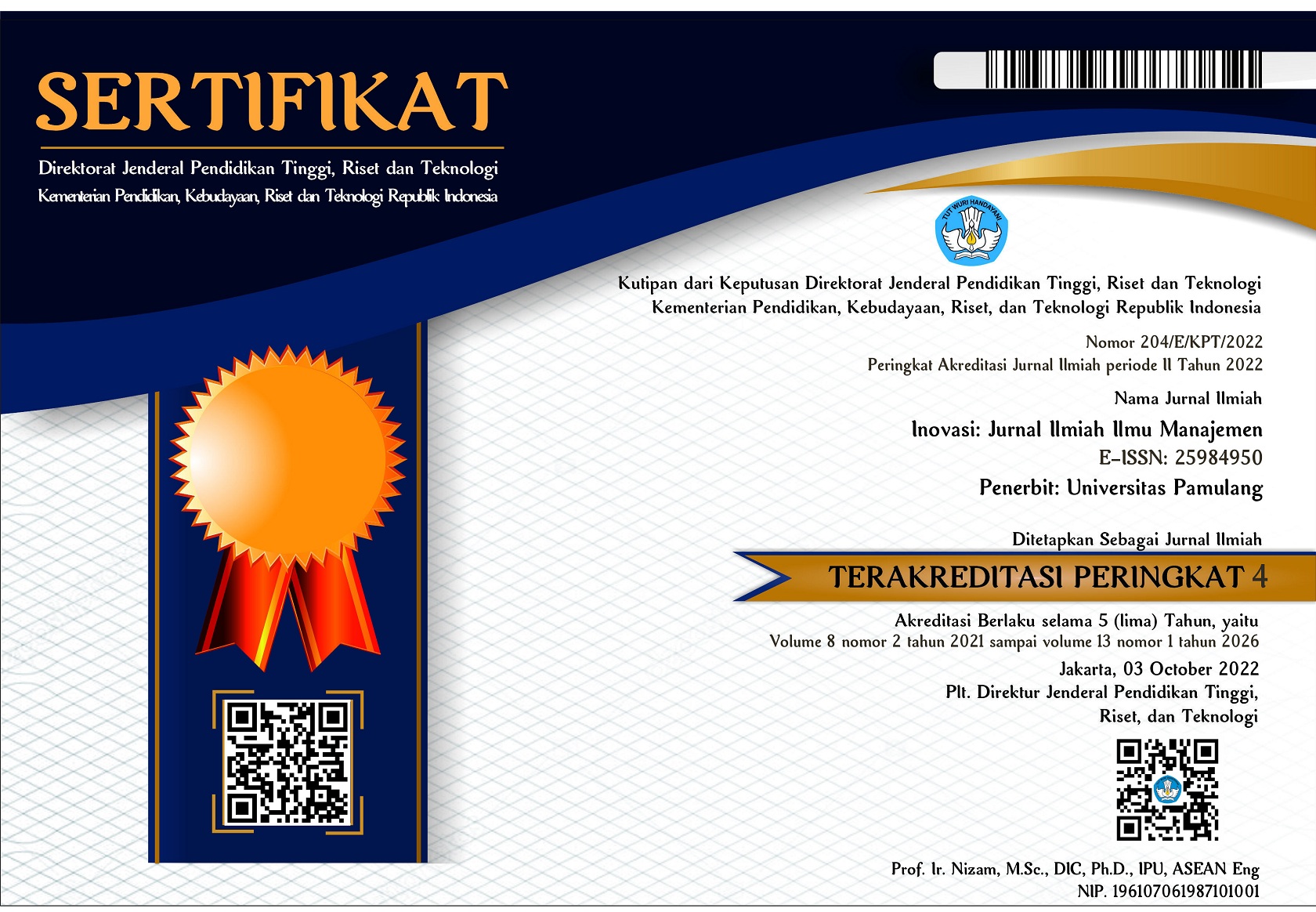PERFORMANCE DETERMINANTS OF STATE CIVIL SERVICES (ASN) IN THE COVID-19 PANDEMIC
DOI:
https://doi.org/10.32493/Inovasi.v8i1.p54-61.13189Abstract
Since the Covid-19 outbreak in May 2020 there has been a shift in work patterns and systems in various agencies and companies, including the government. This is done as a form of adaptation to the situation, especially in preventing the spread of the Covid-19 virus. But on the other hand the organization must continue to run, therefore there is a work from home work model. This concept exists because of circumstances, so that various shortcomings arise, one of which is work activities do not run effectively and have an impact on decreasing employee performance. In fact, this research was conducted to find out this phenomenon, and what factors have linearity on employee performance. The research method used in answering the research hypothesis is quantitative with statistical regression (forecasting). The research sample was BPPT employees totaling 80 people, with a simple random sampling technique. The results of the study recommend that the model that best improves performance during the pandemic is the simultaneous model. This means that factors directly related to employee performance have a major impact on improving performance, including high morale, proportional workload, and career openness. In other words, institutions must be sensitive to the determinants of performance, both under normal circumstances or in a pandemic.
References
Spinelli, R., Magagnotti, N., & Labelle, E. R. (2020). The effect of new silvicultural trends on mental workload of harvester operators. Croatian Journal of Forest Engineering: Journal for Theory and Application of Forestry Engineering, 41(2), 1-13.
Galy, E. (2020). A multidimensional scale of mental workload evaluation based on Individual–Workload–Activity (IWA) model: validation and relationships with job satisfaction. Tutorials in Quantitative Methods for Psychology, 16, 240-252.
da Cruz Carvalho, A., Riana, I. G., & Soares, A. D. C. (2020). Motivation on job satisfaction and employee performance. International Research Journal of Management, IT and Social Sciences, 7(5), 13-23.
Harras, H., Sugiarti, E., & Wahyudi, W. (2020). Kajian Manajemen Sumber Daya Manusia Untuk Mahasiswa.
Anggraeni, F. N. (2020). DETERMINAN MOTIVASI INTERNAL TERHADAP KINERJA. SCIENTIFIC JOURNAL OF REFLECTION: Economic, Accounting, Management and Business, 3(2), 161-170.
Rahmi, A., Achmad, G. N., & Adhimursandi, D. (2020). The Effect of Leadership and Empowerment Style and Motivation on Work Discipline and Employee Performance in Sungai Kunjang Subdistrict, Samarinda City. International Journal of Business and Management Invention (IJBMI), 9(3), 8-14.
Wahyu, W., & Salam, R. (2020). KOMITMEN ORGANISASI (Kajian: Manajemen Sumber Daya Manusia).
Wahyudi, M. (2019). PENGARUH DISIPLIN DAN MOTIVASI TERHADAP KINERJA KARYAWAN. SCIENTIFIC JOURNAL OF REFLECTION: Economic, Accounting, Management and Business, 2(3), 351-360.
Anggraeni, F. N. (2020). SURVEY MOTIVASI KERJA DRIVER OJEK ONLINE GRAB. SCIENTIFIC JOURNAL OF REFLECTION: Economic, Accounting, Management and Business, 3(3), 251-260.
Efendi, R., Rifa'i, M. N., Bahrun, K., Milla, H., & Suharmi, S. (2020). The mediation of work motivation on the effects of work discipline and compensation on performance batik msmes employees in yogyakarta city, indonesia. International Journal of Multicultural and Multireligious Understanding, 7(1), 689-703.
Purba, K., & Sudibjo, K. (2020). The Effects Analysis of Transformational Leadership, Work Motivation and Compensation on Employee Performance in PT. Sago Nauli. Budapest International Research and Critics Institute (BIRCI-Journal): Humanities and Social Sciences, 3(3), 1606-1617.
Rojas-Valverde, D., Gómez-Carmona, C. D., Oliva-Lozano, J. M., Ibáñez, S. J., & Pino-Ortega, J. (2020). Quarter’s external workload demands of basketball referees during a European youth congested-fixture tournament. International Journal of Performance Analysis in Sport, 20(3), 432-444.
Kuijpers, E., Kooij, D. T., & van Woerkom, M. (2020). Align your job with yourself: The relationship between a job crafting intervention and work engagement, and the role of workload. Journal of occupational health psychology, 25(1), 1.
Creed, P. A., Kaya, M., & Hood, M. (2020). Vocational identity and career progress: The intervening variables of career calling and willingness to compromise. Journal of Career Development, 47(2), 131-145.
Chui, H., Li, H., & Ngo, H. Y. (2020). Linking protean career orientation with career optimism: career adaptability and career decision self-efficacy as mediators. Journal of Career Development, 0894845320912526.
Alvi, A. K., Jabeen, Z., Jawaid, A., & Kaur, P. (2020). Relationship of Career Success and Organizational Performance Through the Path of Business Strategy. International Journal of Economics, Management and Accounting, 28(1), 1-33.
Kong, H., Okumus, F., & Bu, N. (2020). Linking organizational career management with Generation Y employees’ organizational identity: The mediating effect of meeting career expectations. Journal of Hospitality Marketing & Management, 29(2), 164-181.
Downloads
Published
How to Cite
Issue
Section
License
Authors who publish with this journal agree to the following terms:
- Authors retain copyright and grant the journal right of first publication with the work simultaneously licensed under a Creative Commons Attribution License that allows others to share the work with an acknowledgement of the work's authorship and initial publication in this journal.
- Authors are able to enter into separate, additional contractual arrangements for the non-exclusive distribution of the journal's published version of the work (e.g., post it to an institutional repository or publish it in a book), with an acknowledgement of its initial publication in this journal.
- Authors are permitted and encouraged to post their work online (e.g., in institutional repositories or on their website) prior to and during the submission process, as it can lead to productive exchanges, as well as earlier and greater citation of published work (See The Effect of Open Access).
INOVASI: journal of managenet have CC-BY-SA or an equivalent license as the optimal license for the publication, distribution, use, and reuse of scholarly work.
In developing strategy and setting priorities, INOVASI: JOURNAL OF MANAGEMENT recognize that free access is better than priced access, libre access is better than free access, and libre under CC-BY-SA or the equivalent is better than libre under more restrictive open licenses. We should achieve what we can when we can. We should not delay achieving free in order to achieve libre, and we should not stop with free when we can achieve libre.









